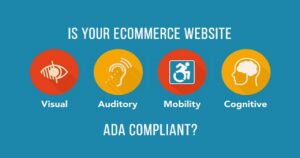The American Disabilities Act has mainly been considered from a physical perspective. Over the years, it has been property and business owners who have endeavored to make their premises compliant. However, the scenario changed from 2010 when the Department of Justice released a new interpretation of the Act. The phrase “places of accommodation” was meant to include websites and other online content that can be found on the internet. Therefore, the website that has content or components that are significantly inaccessible and thus non-compliant to the ADA will be considered in violation of the act, specifically Title III.

As a website owner, you might have various reasons that explain why your website is not compliant. You may argue that the website is still a work in progress. You may state that you weren’t aware. You might even state that you already have company policies that state your support of the disabled. That any and all excuses will not hold water. The American Disabilities Act and all its related provisions (including the Web Content Accessibility Guidelines) are strict liability laws. Therefore, there is no defense for violation.
If you are looking to make your website compliant with the ADA and specifically WCAG provisions, this post will come in handy. Check out the short compliance checklist that we compiled. We will look at Level A and Level AA standards as per the WCAG. You can hire a web designer who can make the changes recommended.
Level A standards (lowest)

These are the minimum features and characteristics that any website should have. However, they don’t achieve accessibility in many situations.
- There should be a variety of content on your website: text, video, audio, and images.
- The text should be well presented, readable, and with proper headings that are in a logical, sequential order.
- The video should have captions.
- The user should be able to navigate through your content either using the keyboard or the mouse independently.
- There should be no strobe effects or rapidly flashing color.
- Any links provided should be identified.
- Your website should be able to identify and correct any errors made by the user.
Level AA standards (mid-range)
The standards recommended here suggest solutions to the more common obstacles for disabled users.
- Any redundant link on one page should be removed.
- All underlined texts should be provided with a link. Otherwise, they should be plain text.
- Error preventive and corrective measures whenever the user is inputting data.
- The website should offer suggestions to the user on how to solve mistakes.
- Pages should have a zoom range of 200%.
- The focus of the keyboard should be visible.
We recommend you read the WCAG to get acquainted with what is asked of your website and reduce the possibility of being sued. The checklist provided is not a complete guide but only one that allows you to appreciate the effort of making your website ADA compliant.


